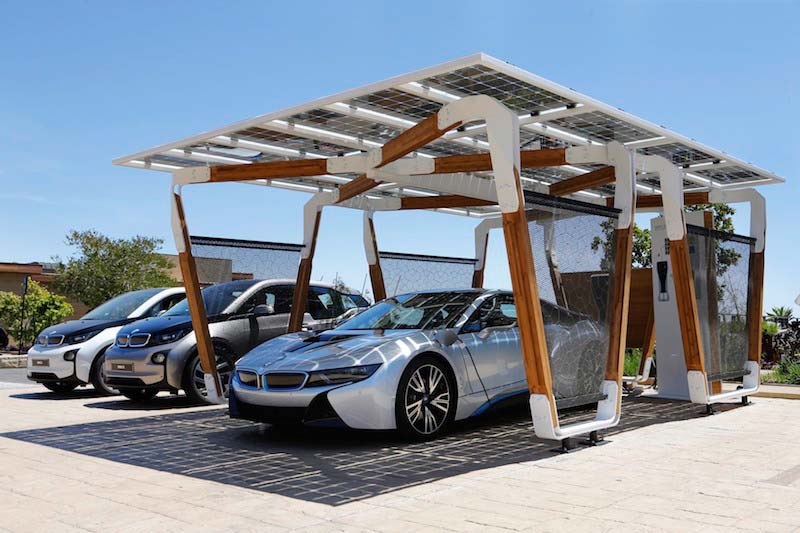Solar Carports, Incentives and the Investment Tax Credit—It’s Complicated, Kinda
Written by Chris Meehan
Updated August 13, 2021
4 minutes read
Categories: Solar 101, Solar financing, Solar incentives, Solar panels, Solar power
Sometimes you can't do rooftop solar. It just doesn't work out because your roof isn't facing the right direction or is shaded by trees or another building. Thankfully there are other options like ground mount systems or, perhaps even better, solar carports or canopies and most, if not all of the same incentives, like the Investment Tax Credit (ITC) still apply.

While ground-mount solar systems may be a little cheaper solar carports and solar canopies turn a solar photovoltaic installation into a dual-purpose structure. The structure provides both shade or protection for a vehicle and clean, renewable energy. Since they're dual-use, the systems don't require the excess land that a ground-mount solar system does making the best use of available space.
Solar carports are also ideal structures for larger, commercial spaces, like parking lots. As such more commercial entities—everything from big box stores like Ikea to stadiums and apartment buildings are installing solar canopies. They also can be combined with electric vehicle chargers to provide a clean charging solution for your vehicles.
Reports claim that solar carports are going to be one of the next big things and more are being built at homes and commercial entities. Some states are also pushing for more solar carports and canopies with specific incentives. Among those states are Maryland and Massachusetts.
Maryland has a grant program for commercial-scale PV canopies. In Massachusetts, the new SMART program (Solar Massachusetts Renewable Target) includes incentive adders for solar canopies, for instance. The adder incentive for power from solar carports could be as much as 6 cents per kilowatt-hour more under the SMART program there. That's why it's wise to check with local solar installers to see what incentives you can qualify for.
At the federal level, things are a bit more complicated for solar carports and canopies. The Investment Tax Credit (ITC), which currently (as of 2017) reimburses people for 30 percent of the cost of solar panels and equipment does apply to solar carports—kind of. When the program was extended at the end of 2015, the IRS made some changes to what it covers regarding solar canopies.
Good Ole Form 5965
The IRS instructions for the ITC, Form 5695, explains what solar carport expenses can qualify for the ITC. It states: "Qualified solar electric property costs are costs for property that uses solar energy to generate electricity for use in your home located in the United States. No costs relating to a solar panel or other property installed as a roof (or portion thereof) will fail to qualify solely because the property constitutes a structural component of the structure on which it is installed. The home doesn't have to be your main home."
See how much solar could save you
So what exactly does all that mean?
Well, solar carports can be covered under the ITC, if they're made explicitly to host the solar array. At least the structural components can be. It's also different for residential solar systems than it is for commercial solar systems. Residential solar systems are covered under Section 25D of the law (via Cornell's Legal Information Institute). It states that: "The term "qualified solar electric property expenditure" means an expenditure for property which uses solar energy to generate electricity for use in a dwelling unit located in the United States and used as a residence by the taxpayer."
Labor costs may also be considered in claiming the ITC, the law explains: "Expenditures for labor costs properly allocable to the onsite preparation, assembly, or original installation of the property described in subsection (d) and for piping or wiring to interconnect such property to the dwelling unit shall be taken into account for purposes of this section." It's a little muddy in its wording, and unfortunately the IRS's Q&A regarding Section 25D hasn't been updated since the ITC was extended to offer more clarity. As such it's best to talk both with your solar installer and your tax professional to better understand which and costs can be covered under the ITC and which can't be covered.
Then there's Section 48 for Commercial Solar Carports
Commercial solar carport installations can be much larger than residential carports, covering 10s if not potentially hundreds of spaces in a parking lot. They are covered under Section 48 of the law. The Solar Energy Industries Association (SEIA) explains that "a broader regulatory project is also underway defining what property qualifies as solar energy property as defined under Section 48. Examples of property under consideration are energy storage, carports, solar canopies and roofing."
Zenergy, a energy finance advisory services company that provides services for commercial solar installations has a handy table of what should be eligible to qualify for the ITC tax credit. It explains that a carport structure should be covered under the ITC, but only if its underside is exposed. But it also clarifies that painting the carport or repaving the parking lot because of the carport wouldn't be covered.
What it all boils down to is talk with the experts. Solar installers should know the local rules and regulations as well as incentives and can tell you what incentives your solar carport is eligible for. Again, it's also a good idea to talk with your tax expert to make sure you don't claim anything you shouldn't.